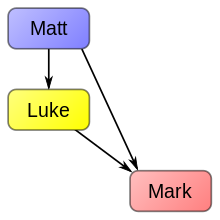
Back فرضية الانجيلين ARZ Zwei-Evangelien-Theorie German Hipotesis dua injil ID Ipotesi Griesbach Italian
| Griesbach hypothesis | |
 | |
| Theory Information | |
|---|---|
| Order | Matt Luke Mark |
| Additional Sources | No additional sources |
| Gospels' Sources | |
| Mark | Matt, Luke |
| Luke | Matt |
| Theory History | |
| Originator | Henry Owen |
| Originating Work | On Dispensing with Q |
| Origination Date | 1764 |
| Proponents | Johann Jakob Griesbach Friedrich Andreas Stroth William R. Farmer |
The two-gospel hypothesis or Griesbach hypothesis is that the Gospel of Matthew was written before the Gospel of Luke, and that both were written earlier than the Gospel of Mark.[1] It is a proposed solution to the synoptic problem, which concerns the pattern of similarities and differences between the three Gospels of Matthew, Mark, and Luke. The hypothesis is generally first credited to Johann Jakob Griesbach writing in the 1780s; it was introduced in its current form by William R. Farmer in 1964 and given its current designation of two-gospel hypothesis in 1979.
The two-gospel hypothesis contrasts with the two-source hypothesis, the most popular and accepted scholarly hypothesis. Supporters say that it does not require lost sources like the Q source and was supported by the early Church. Proponents of the two-gospel hypothesis generally also support the traditional claims of authorship as accurate to disciples and their direct associates, which implies the gospels were written comparatively soon after Jesus's death, rather than the later dates of authorship supported by other schools of thought.[2]
- ^ Robert L. Thomas (ed.), Three Views on the Origins of the Synoptic Gospels, Kregel Academic, p. 10.
- ^ Beck
© MMXXIII Rich X Search. We shall prevail. All rights reserved. Rich X Search